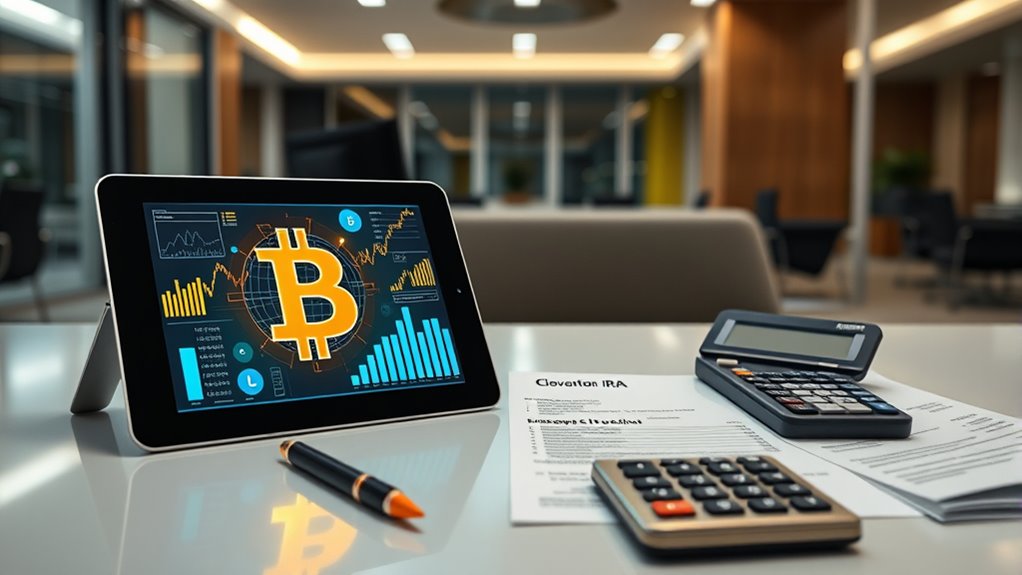A Bitcoin IRA lets you invest in cryptocurrencies for retirement, offering the potential for higher growth but with increased volatility and risk. A traditional IRA mainly includes stocks, bonds, and mutual funds, providing more regulation and stability. While traditional IRAs follow set contribution and withdrawal rules, Bitcoin IRAs require specialized management and detailed tax tracking. Understanding these differences helps you choose the best option for your retirement goals — keep exploring to learn more.
Key Takeaways
- Traditional IRAs offer tax-deferred growth with regulated assets like stocks and bonds, while Bitcoin IRAs focus on cryptocurrency investments with higher volatility.
- Contributions to traditional IRAs are limited annually and withdrawals are taxed as ordinary income; Bitcoin IRAs involve complex tax reporting due to crypto assets.
- Bitcoin IRAs generally carry higher risk due to cryptocurrency price swings, whereas traditional IRAs provide more stable, diversified investment options.
- Management of Bitcoin IRAs often requires specialized custodians and active oversight, unlike traditional IRAs which are easier to manage and regulated.
- Traditional IRAs are more suitable for conservative investors, while Bitcoin IRAs appeal to those seeking high-growth potential despite increased risk.

When deciding between a Bitcoin IRA and a traditional IRA, understanding their fundamental differences can help you make an informed choice. A traditional IRA generally offers tax-deferred growth, meaning you contribute pre-tax dollars, and your investments grow without immediate tax implications. You’ll pay income tax on withdrawals during retirement. In contrast, a Bitcoin IRA involves investing in cryptocurrencies like Bitcoin or Ethereum within a tax-advantaged account. Because cryptocurrencies are considered property for tax purposes, their treatment under cryptocurrency taxation can be complex, especially when it comes to capital gains and reporting requirements. Knowing how these rules apply helps you plan for potential tax liabilities and ensures compliance.
With a traditional IRA, the retirement account rules are straightforward: you can contribute up to the annual limit set by the IRS, and your investments grow tax-deferred until you start taking distributions at age 59½ or later. Early withdrawals typically incur penalties and taxes. A Bitcoin IRA, however, introduces additional considerations. Because cryptocurrencies are more volatile and less regulated than traditional assets, the IRS has specific guidelines on reporting gains and losses. When you sell or trade crypto assets within the IRA, you avoid immediate tax consequences, but you’ll need to keep detailed records for tax purposes. When it comes time to withdraw, the distributions are taxed as ordinary income, similar to a traditional IRA, but the process may involve additional reporting due to the nature of crypto assets.
The core difference also lies in asset diversity. Traditional IRAs often include stocks, bonds, and mutual funds, which are familiar and well-regulated. A Bitcoin IRA focuses solely on cryptocurrencies, which can provide significant growth potential but also carries higher risks. This risk profile influences your investment strategy, especially considering that cryptocurrencies can experience rapid price swings, affecting your retirement savings. Additionally, the self-directed nature of some Bitcoin IRAs allows for a broader range of investment options but requires more active management and due diligence.
Another aspect to consider is how each account type is managed. Traditional IRAs can be self-directed or managed by financial advisors, with clear rules on contributions and distributions. Bitcoin IRAs often require working with specialized custodians or firms experienced in crypto assets, which might involve different fees and management styles. This management complexity can impact your overall retirement planning.
Frequently Asked Questions
Can I Convert My Existing IRA to a Bitcoin IRA?
Yes, you can convert your existing IRA to a Bitcoin IRA through an IRA conversion or a cryptocurrency rollover. You’ll need to contact your current IRA provider and initiate the process, ensuring you follow IRS guidelines to avoid penalties. This rollover allows you to diversify your retirement portfolio with digital assets. Just make sure to consult a financial advisor to understand the tax implications and proper steps for a smooth progression.
What Are the Tax Implications of Bitcoin IRAS?
You’ll need to report your Bitcoin IRA transactions for tax purposes, so stay on top of tax reporting requirements. Unlike traditional IRAs, Bitcoin IRAs can generate taxable events when you take distributions or sell assets, which may impact your investment growth. Keep detailed records of all transactions to guarantee accurate reporting, and consider consulting a tax professional to navigate specific implications and optimize your benefits.
Are Bitcoin IRAS Insured Like Traditional Bank Accounts?
Think of your Bitcoin IRA as a treasure chest in a fortress; while it’s protected, it isn’t insured like a traditional bank account. Insurance coverage for Bitcoin IRAs isn’t automatic, so you need to check if your provider offers specific security measures and insurance options. Unlike banks, where deposits are insured, cryptocurrencies rely on security protocols, so it’s essential to choose a platform with strong security measures to protect your investment.
How Does Diversification Work Within a Bitcoin IRA?
In a Bitcoin IRA, diversification involves spreading your cryptocurrency allocation across different digital assets to reduce risk. You can balance your portfolio by investing in various cryptocurrencies, such as Bitcoin, Ethereum, or altcoins, rather than putting all your funds into one. This approach helps manage volatility and potential growth, allowing you to tailor your investment strategy for better long-term stability and performance within your IRA.
What Are the Annual Maintenance Fees for Bitcoin IRAS?
Like a well-guarded vault, Bitcoin IRAs typically have annual maintenance fees ranging from $50 to $300, depending on the provider. These fees cover cryptocurrency security, account management, and storage. Fee structures vary, so you’ll want to compare costs carefully. Keep in mind, some providers may waive fees for higher balances or offer discounts, helping you keep more of your investment secure and growing.
Conclusion
Choosing between a Bitcoin IRA and a Traditional IRA depends on your risk tolerance and investment goals. Did you know that over 70% of Americans prefer Traditional IRAs for their tax benefits? If you’re comfortable with crypto’s volatility and seeking potential high growth, a Bitcoin IRA might suit you. However, if you prioritize stability and tax advantages, a Traditional IRA could be your best bet. Consider your future plans carefully before making your decision.









